Award-Winning Technology
- Top 10 List of the World's Most Innovative Energy Companies — Fast Company
- Tibbetts Award, “Model of Excellence” — U.S. Small Business Administration
- Outstanding Stewards of America's Waters Award for Operational Excellence — National Hydropower Association
- Emerging Company of the Year Award — New England Clean Energy Council
- Business Leader for the Environment Award — Sierra Club of Maine
- Technology Company of the Year — Technology Association of Maine
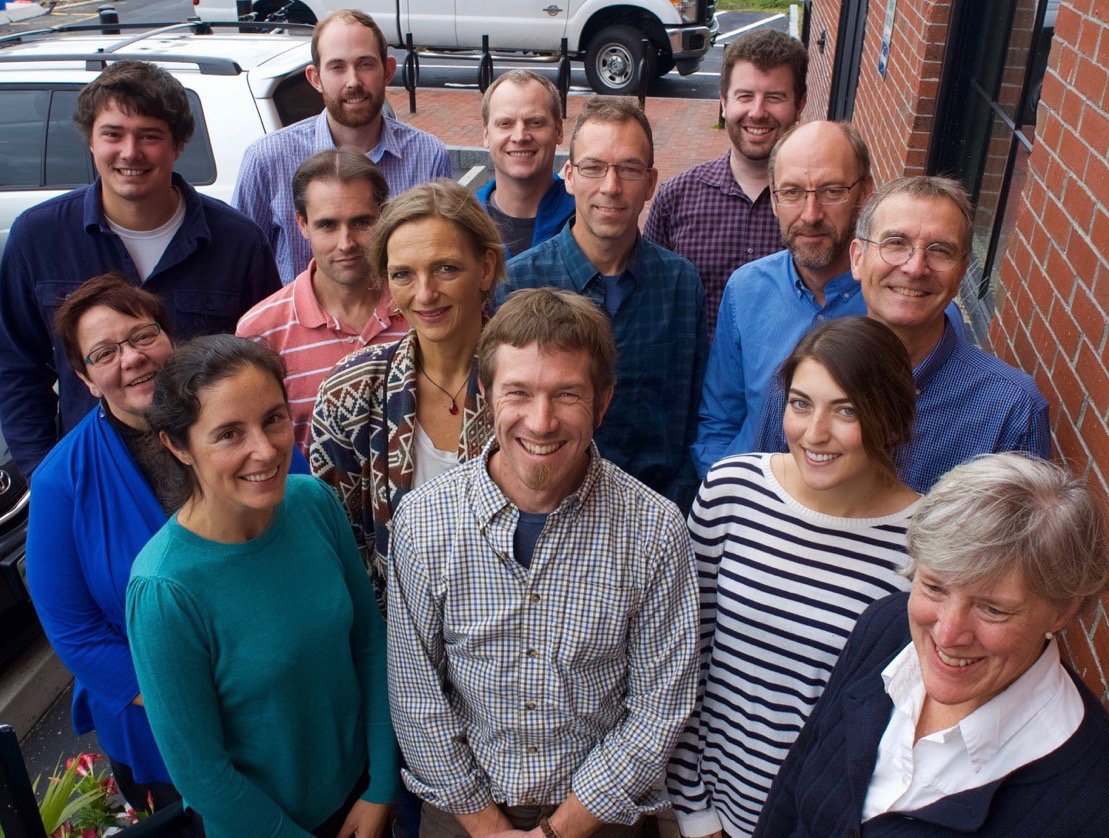
The Problem
Carbon Emissions
Global carbon emissions totaled more than 37 billion metric tons last year, up almost 90% since 1970. This was primarily driven by burning fossil fuels to generate electricity, according to the EPA. If left unchecked, the potential impact on our climate could be devastating.
The Solution
ORPC’s Zero Carbon Energy Solution
Extracting energy from water currents is a clean, sustainable answer to the carbon emissions problem. Water current resources exist in every region of the world, and there is enough extractable energy in water currents to provide one-third of the world’s annual electricity needs. ORPC has developed an award-winning, proprietary energy solution that harnesses the power of water currents, with none of the greenhouse gases generated by fossil fuels.
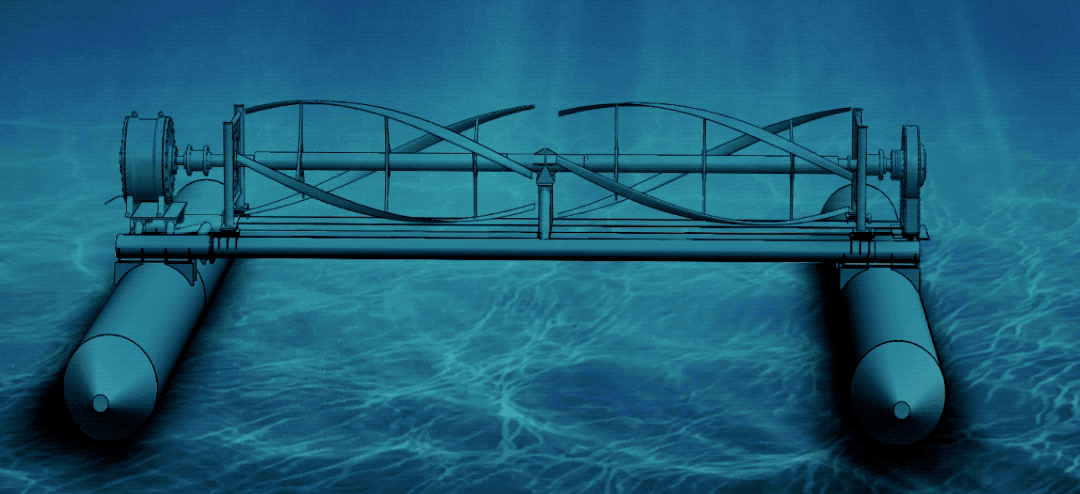
Potential Reduction in Carbon Emissions
Within 20 years, we could avoid pumping nearly 80 million metric tons of carbon dioxide into the environment annually, if ORPC power systems were deployed worldwide. Between now and 2050, this could result in total avoided emissions of over 1.6 billion metric tons of CO2, equivalent to taking 354 million vehicles off the road, conserving 3.8 billion barrels of oil, or retiring 428 coal-fired power plants. If the full potential of this market is achieved, carbon reductions could grow to almost 180 million metric tons annually, or twice the emissions generated by the State of Colorado.

ORPC Power Systems
ORPC power systems are built around our unique and patented core technology, the turbine generator unit or TGU. This unit consists of multiple cross-flow turbines and an underwater generator connected to a single driveshaft, which can be submerged in water as shallow as 5 meters deep. As water currents pass through the TGU, they rotate the turbines and generator, producing electricity. This power is then transmitted through an underwater cable to an on-shore interconnection point.

RivGen® Power Systems
ORPC’s RivGen® Power System connects directly into utility power grids or remote diesel-electric grids. An important and unique feature of the RivGen® Power System is that it is self‐deploying and self-retrieving, requiring only a small‐ to medium‐sized support vessel, commonly available even in remote river or coastal communities. Depending on the speed of the water currents, a RivGen® device generates up to a maximum of 80 kW.
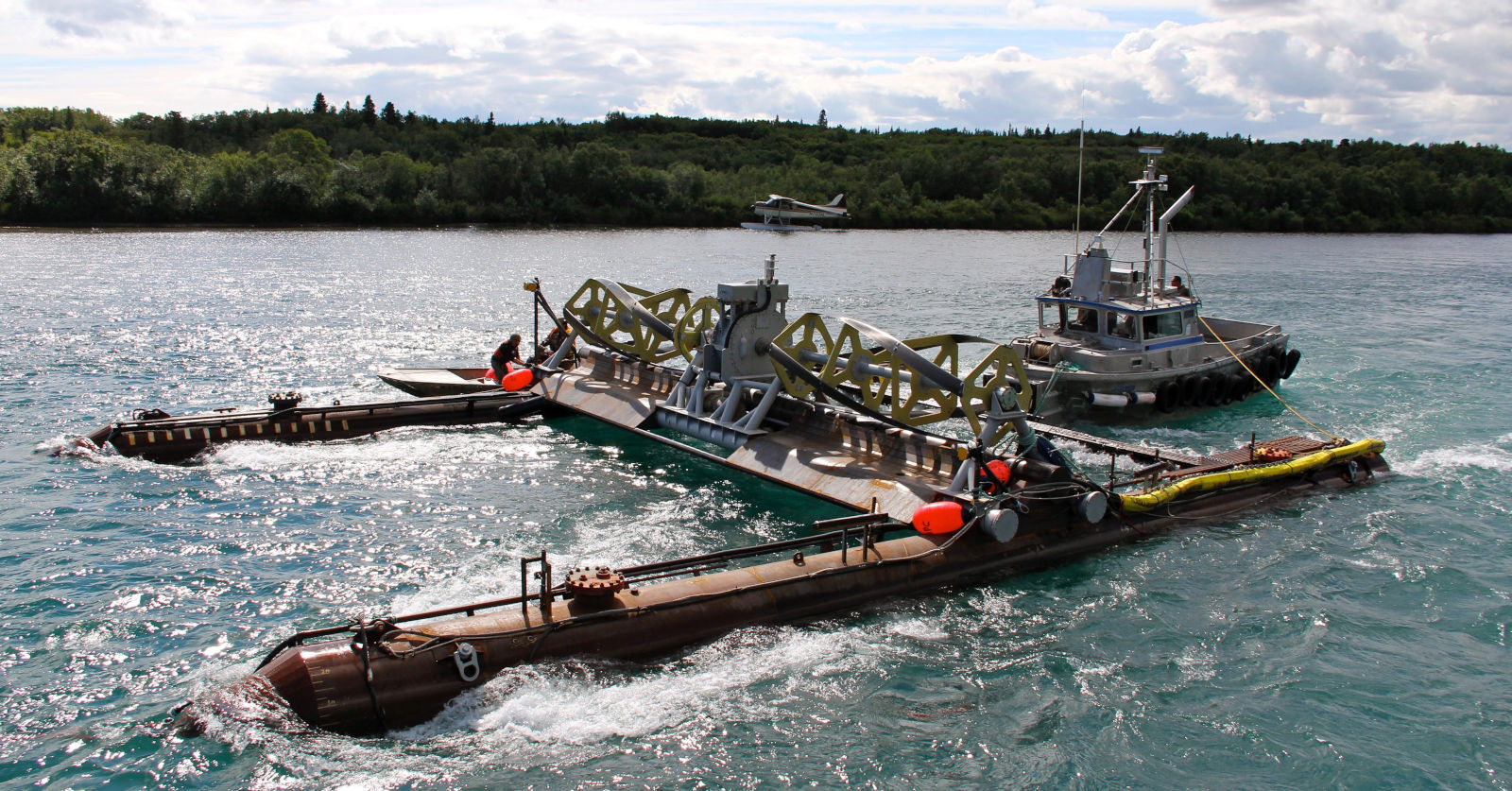
The RivGen® Power System components are transported in intermodal shipping containers to staging areas near a project site and arrive ready for final assembly. When assembled, the RivGen® device is towed to the project site where the anchor has been installed. The device is held by anchor lines and then ballasted into position on the river bed. A power and data cable runs along the river bottom to an on‐shore interconnection point. Any number of RivGen® devices can be installed at a site in this manner, depending on community needs and site characteristics.
TidGen® Power Systems
TidGen® is a suite of power generation devices that individually can generate up to 700 kW of power from tidal or ocean currents, depending on their configuration and the velocity of the currents. These power systems provide flexibility and adaptability to a full range of site conditions and can be deployed in sites as shallow as 15 meters and as deep as several hundred meters. They can be located within the water column at the location of highest power density, maximizing power output. The TidGen® TGU is positively buoyant and is secured to anchors on the bottom using a tensioned mooring system. Depending on community and/or regional power grid needs and project site characteristics, a TidGen® Power System installation can include up to several dozen TidGen® devices.

TidGen®4 Device
The TidGen®4 device was designed for community-scale tidal (or river) projects and can be deployed and retrieved using only assets typically available in communities where little installation infrastructure exists. The TidGen®4 device contains two rows of double cross‐flow turbines and can generate up to 350 kW, depending on current velocity.

TidGen®8 Device
The TidGen®8 device is larger than the TidGen®4 with two rows of four turbines. It is capable of generating up to 700 kW, depending on water current velocities.
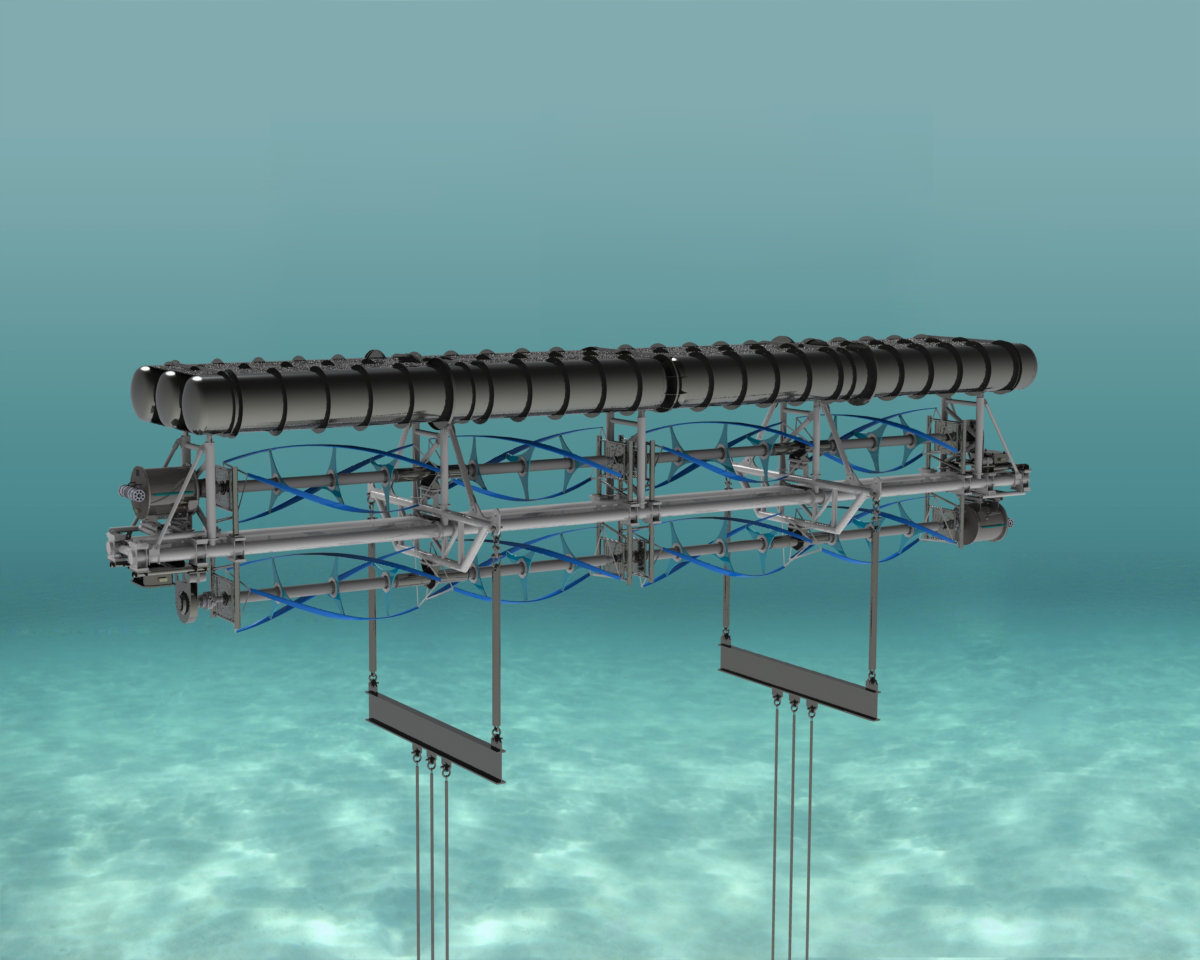
Autonomous TGU
ORPC’s Autonomous TGU (ATGU) is in development, funded in part by the U.S. Department of Energy’s ARPA‐E program. This subsea power generation module is a self‐propelling, self‐deploying, self‐retrieving, electricity generating system capable of performing heavy lifts. The ATGU generates power from currents greater than 1 meter per second with a rated capacity of 4 kW at a flow speed of 2.25 meters per second. The active pitching system can switch from power generation mode to propulsion mode so that the entire power system can actively self‐deploy and self‐retrieve from the seafloor with the use of a small vessel. The ATGU can relocate from an energetic tidal site where the system charges its battery bank, to a less energetic site where the charged battery bank can deliver power to an unmanned underwater vehicle charging system.
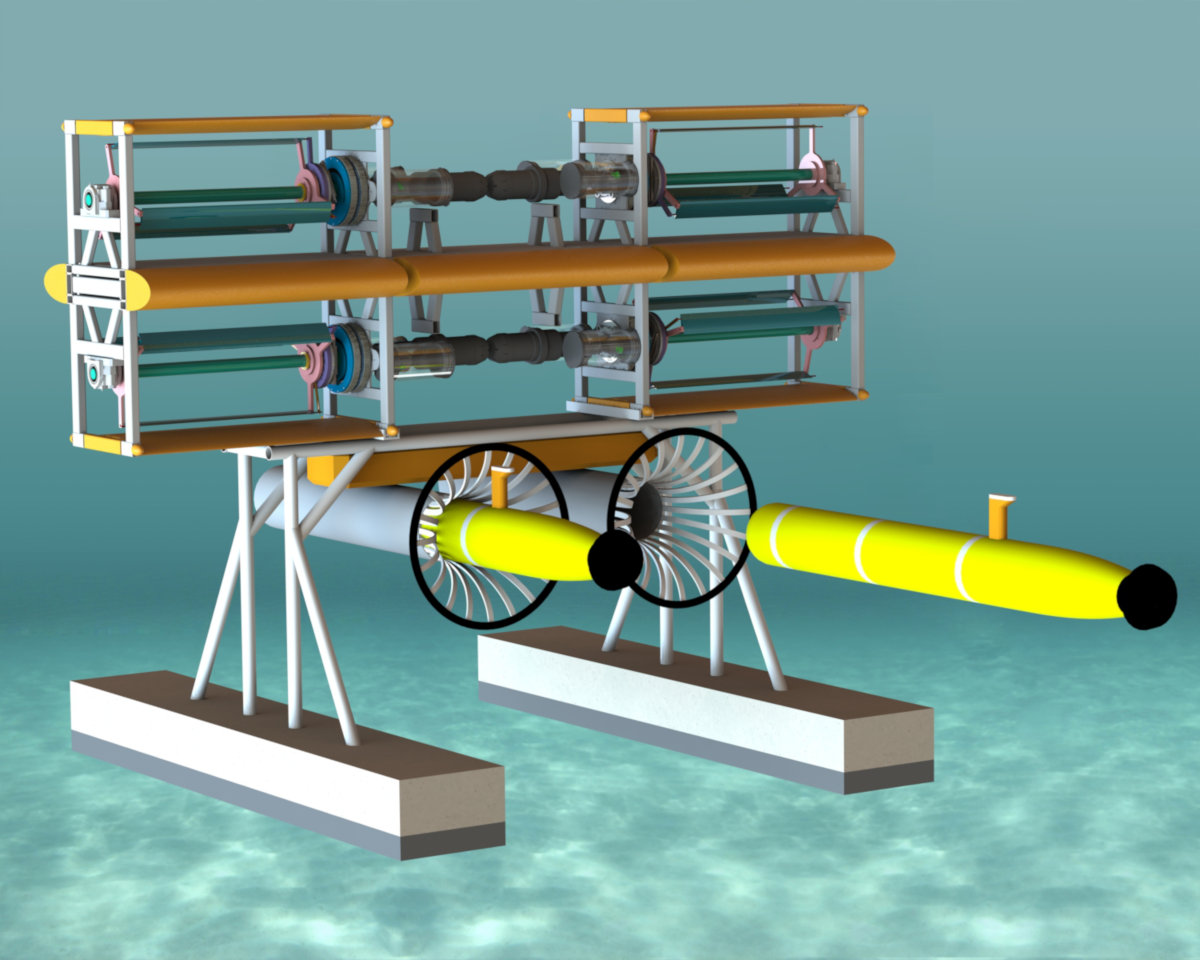
Potential market applications include distributed subsea power (such as scientific observation and data collection systems), underwater surveillance and monitoring, subsea construction and salvage, and offshore oil and gas operations.
Advantages
Advantages vs. Wind and Solar Power
- ORPC power systems are able to achieve significantly higher levels of renewable energy penetration on the grid, as compared to wind and solar.
- Because they are completely submerged, ORPC systems do not block views and have no navigation, noise or floating debris issues.
- Given the significant power density of water currents, our systems use only 2% of the land area required for wind or solar.
- Unlike the wind and sun, tidal, river, and ocean currents are reliable and predictable and not subject to sudden, unpredictable variations or adverse weather.
- Solar and wind are not the best alternatives in extreme latitudes, due to lack of year-round sunlight and harsh, frigid, icy weather conditions. Being submerged underwater in extreme weather conditions is a significant advantage.
Technical Advantages
- ORPC’s advanced-design cross flow turbines rotate in the same direction in both ebb and flood tidal currents; no mechanical repositioning to the flow is needed.
- The direct‐drive (no gears) TGU has a lower vertical profile that allows for deployment in shallower sites, increasing our market potential.
- Our devices are easier to deploy and retrieve using commonly available marine equipment and locally available personnel.
- Requiring fewer assets and a smaller weather window, ORPC’s power systems present dramatically reduced installation, operational, and maintenance costs and risks.
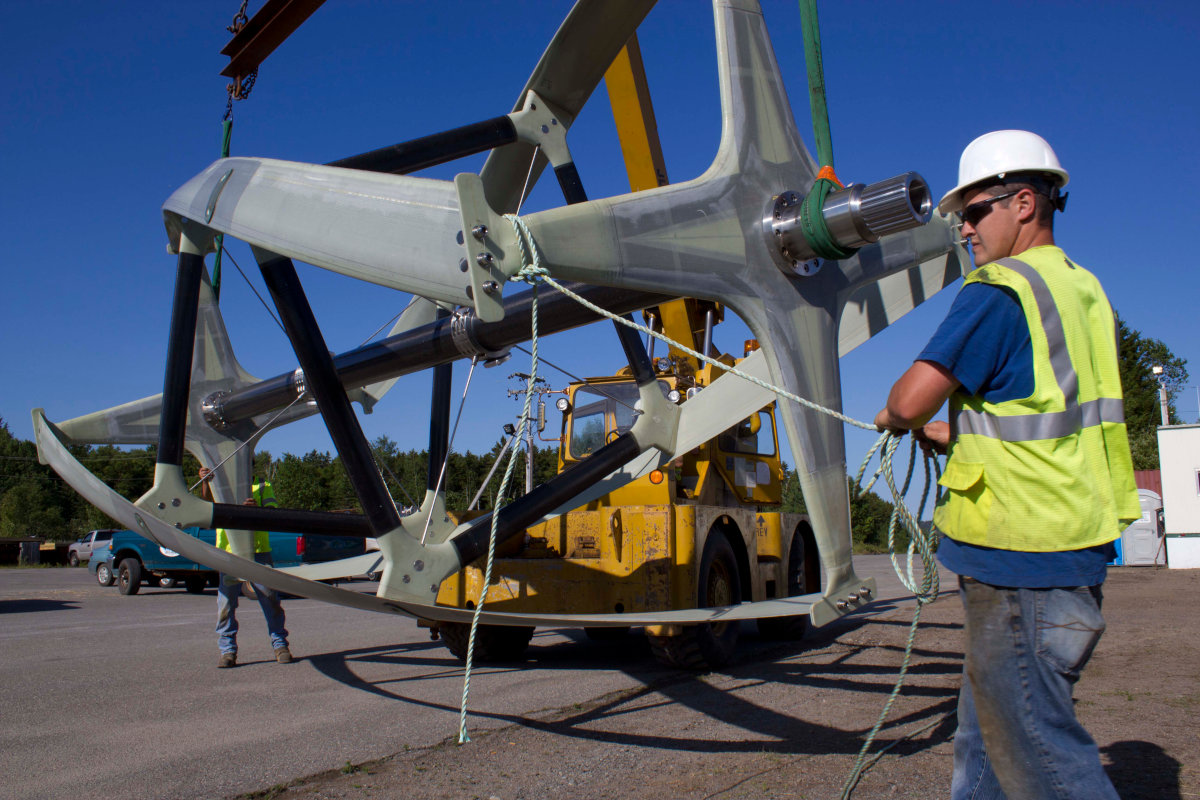
Market Opportunity
With our current technology, we estimate ORPC’s total addressable market is approximately $480 billion. Robust market opportunities for marine renewable energy exist in off‐grid and regional and national on-grid locations around the globe. In remote off‐grid locations, there are significant market opportunities in local communities and industrial facilities, such as mining, where electricity is very expensive and has limited or no availability. Even larger market opportunities exist in locations currently served by large, centralized grids in countries where the cost of electricity is high (above $0.20/kWh).
Immediate Market Opportunity in Islanded Communities
Our immediate focus is the more than two billion people who live in isolated regions, commonly referred to as “islanded” communities. They are surrounded by water or uninhabited land, with no access to a regional power grid or fuel pipelines. These include rural communities at the end of electricity supply networks and traditional remote communities that are wholly isolated from centralized grid infrastructures. Most islanded communities that do have access to electricity are totally reliant on power generated by imported fossil fuels (primarily diesel), resulting in high energy costs and environmental damage that threaten long‐term sustainability and hamper economic development. For these communities, the cost of electricity is 5 to 15 times higher than the average paid by customers on utility-scale grids.
We estimate that marine renewable energy could replace 1.6 gigawatts of currently installed diesel-generating capacity in these communities. This estimate comprises communities located across North and South America that are currently reliant on diesel fuel and located near potential hydrokinetic resources. This represents a revenue opportunity for ORPC of over $16 billion.
We are penetrating this market segment through identified customers in Alaska, northern Québec (Nunavik), Nunavut, Nova Scotia, and southern Chile.

Cobscook Bay Tidal Energy Project
ORPC made history in 2012 when we built and operated the first revenue‐generating, grid‐connected tidal energy project in North America and the first ocean energy project to deliver power to a utility grid anywhere in the Americas. Called the Cobscook Bay Tidal Energy Project and funded in part by a highly competitive $10 million award from the U.S. Department of Energy, the Project was installed at a site located near the U.S./Canadian border at the mouth of the Bay of Fundy, off the coast of Eastport and Lubec, Maine.

Igiugig RivGen® Power System Project
In 2014, ORPC built and operated our first river energy project, delivering power to the remote Alaskan village of Igiugig. Working in collaboration with local villagers, ORPC made technology upgrades and re‐installed and operated the RivGen® Power System in Igiugig in 2015, demonstrating a one-third improvement in performance and providing one-third of the community’s electricity needs. This second deployment proved again the efficacy of the self‐deployment and self‐retrieval capabilities of the system.
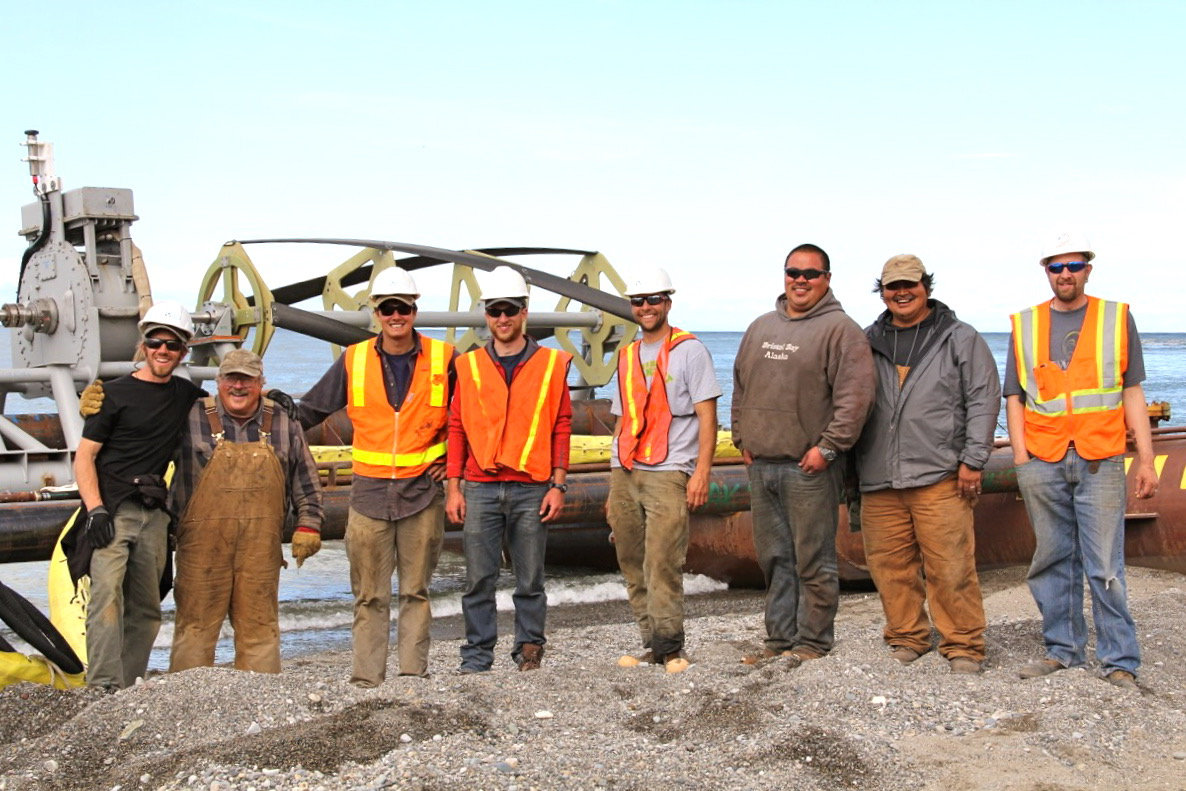
Business Model
ORPC sells marine renewable energy power systems and associated services to customers worldwide. Our revenue streams include:
- Sales of power systems;
- Development services, including permitting and site characterization;
- Technical services, such as operations and maintenance, monitoring, training, overhaul and repair, and upgrades;
- Technology licensing; and
- Electricity sales from projects in which ORPC is an owner.
We are also in negotiations with an independent financing company that plans to set up a systems leasing company (LeaseCo) to provide outside capital to purchase ORPC power systems and lease them to ORPC customers. LeaseCo could significantly increase market acceptance and accelerate market penetration for ORPC as it would make it easier for customers, particularly early adopter customers, to acquire ORPC power systems.
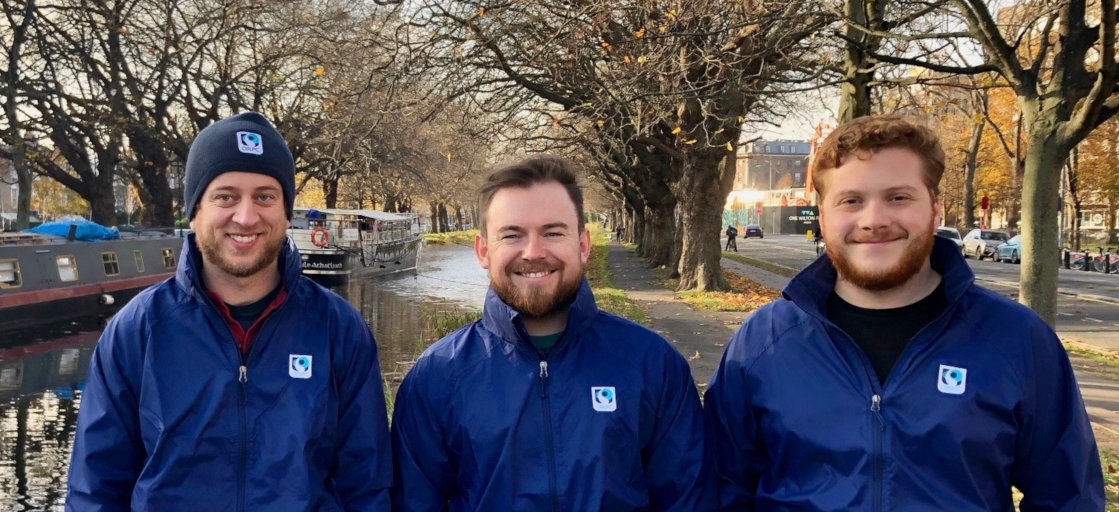
Success to Date
- Raised over $90 million in public/private capital
- Awarded 37 highly competitive grants by U.S. federal and state governments, including the U.S Department of Energy and U.S. Department of Agriculture, as well as Canadian, Irish, and European Union agencies
- Successfully completed 11 deployments of ORPC power systems in both tidal and river applications
- Granted 39 patents
- Received “no adverse environmental impacts” determination by federal and state regulatory agencies
- First company in the Americas to deliver power to a utility grid from an ocean energy project of any type (not involving a dam)
- First company in the U.S. to negotiate and execute a long‐term power purchase agreement for power from a marine renewable energy project
- Only company in the world to deliver power to grids from both a tidal and a river marine renewable energy project
- 2016 winner of the National Hydropower Association’s “Outstanding Stewards of America’s Waters” award for Operational Excellence for the Igiugig, Alaska, RivGen® Power System Project
- Approved for Technology Qualifications: Statement of Feasibility, Certification Report and Certification Plan by DNV GL, an international accredited registrar and classification society
- Developed strong relationships with leading research and technology centers in North America and Europe, including:
- The Pennsylvania State University Applied Research Laboratory
- University of Washington, Pacific Marine Energy Center
- University of Maine, School of Marine Science
- University of Maine Advanced Structures and Composites Center
- Dartmouth College, Thayer School of Engineering
- University of New Hampshire Center for Ocean Engineering
- University of Alaska Anchorage
- University of Alaska Fairbanks Center for Energy and Power
- National Renewable Energy Laboratory
- Sandia National Laboratories
- National Research Council of Canada
- Laval University
- University College Cork
- Executed a joint development agreement with Hydro‐Québec for research and development in marine energy
- Established a memorandum of understanding with CIMA+ for collaboration to advance sales of ORPC power systems, and a letter of intent with the Makivik Corporation to form a new joint business entity that will develop, own, and operate marine renewable energy projects in Nunavik
- Developed partnerships with key suppliers of turbines, generators and power electronics
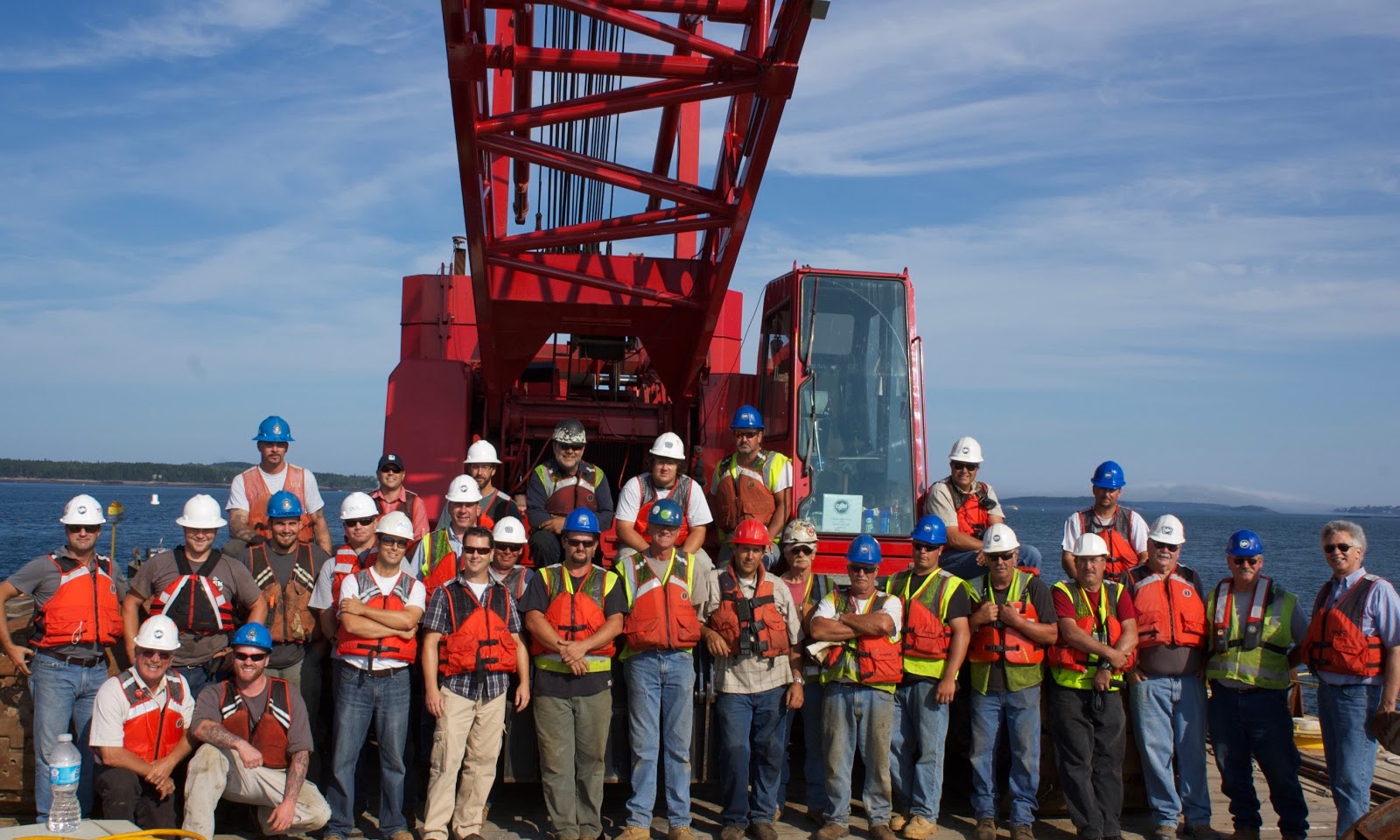
Press Highlights
“The Energy Fix: Engineering Triumphs Over Wave And Tidal Forces” — Popular Science
“In Maine, a US first in tidal energy” — Boston Globe
“The Search for Energy Takes a Turn Underwater” — The New York Times
“Ocean Renewable Power Co. calls Alaskan pilot project a 'huge success'” — Mainebiz
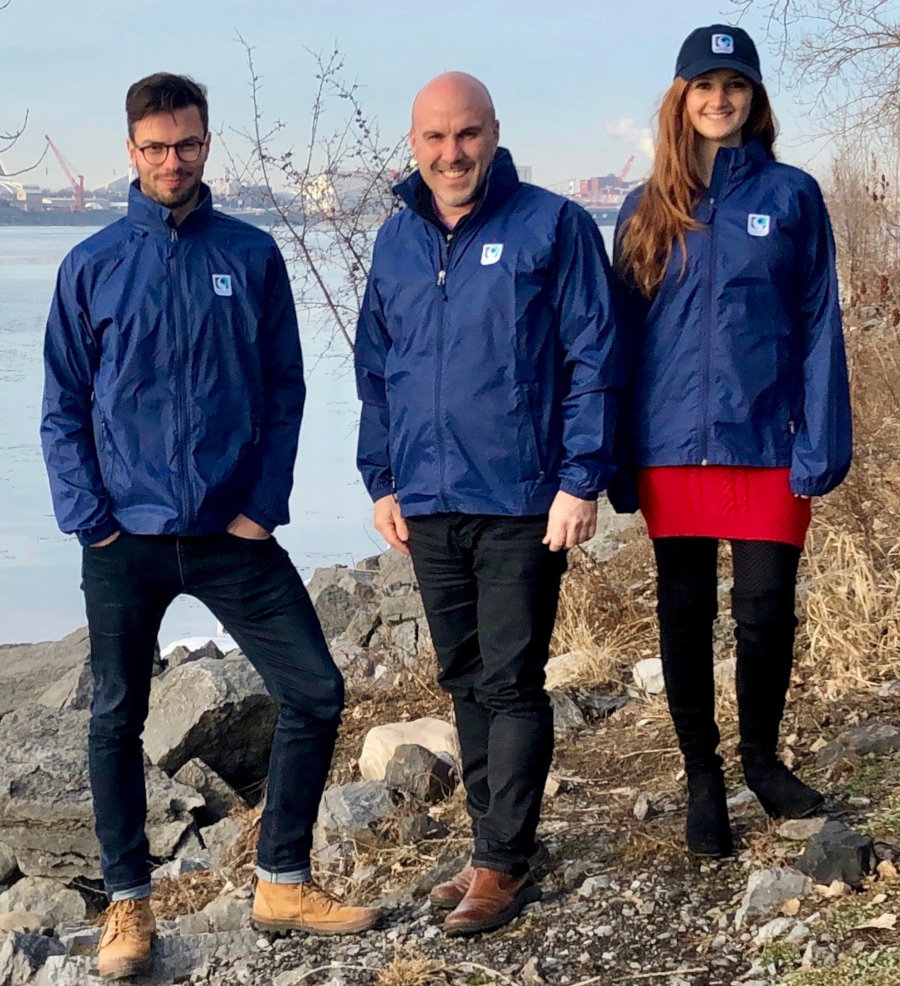
Team
ORPC is led by an accomplished, entrepreneurial management team and advisory board with extensive experience in the electric power industry and proven track records in developing, permitting, financing, constructing, operating and managing co‐generation, independent power and renewable energy facilities. Team members have also successfully formed, funded, and managed technology development and start‐up companies.
Mr. Sauer provides leadership to all the technical and commercial activities required to commercialize ORPC’s technology and develop, finance, and build ORPC’s projects. He is a former energy entrepreneur and strategic development consultant with more than 40 years of experience in the project development, electricity, cogeneration, renewable energy and energy efficiency industries. Mr. Sauer has a proven track record in developing new energy facilities and energy and environmental technologies, structuring complex transactions and starting up and managing new organizations. He has held senior management positions with two major U.S. corporations – Wheelabrator Technologies and PG&E National Energy Group – and has been president and CEO of two startup energy/environmental technology companies. He has been in the energy transaction business since 1977, and since that time, has played an instrumental role in the business plan development, financing and executive management of two startup technology companies and the development of more than $2 billion in energy assets.
Mr. Paris provides leadership and manages the day-to-day operations of ORPC’s wholly-owned Canadian subsidiary, ORPC Canada. Mr. Paris comes to ORPC as a seasoned entrepreneur, executive and engineer with more than 20 years’ experience working in the private and public sectors in Canada, the U.S., Europe, and Asia. Fluent in French and English, Mr. Paris has had broad exposure to world‐class organizations, as well as small to medium size corporations. Most recently, Mr. Paris was Senior Manager, Growth & Innovation, for Hydro-Québec. Recognized for his ability to design and implement innovative methods, he has a demonstrated ability to mobilize teams, optimize operations and grow businesses.
Mr. Ferland is responsible for the day-to-day management of the Company and its subsidiaries. In this role, he oversees the implementation of business practices, strategies, plans, and procedures; development of metrics and performance analysis to help ensure the Company’s high performance; and interaction and collaboration among all Company functional teams in meeting Company goals. Because of his specific expertise in commercialization and project development, Mr. Ferland is also directly responsible for all business and project development activities. He draws on over 30 years of experience encompassing technology commercialization, renewable energy development, port emergency response operations and coastal resources management. He has served as CEO of an oil spill response company, mentored numerous startups as director of a technology entrepreneur assistance program, and was the founding president of the Environmental & Energy Technology Council of Maine, now the leading industry association for clean technology companies in northern New England.
Mr. McEntee leads the development of the Company’s proprietary hydrokinetic energy technology. He earned his Bachelor of Engineering in Mechanical Engineering at University College in Dublin, Ireland, in 1986 and his Master of Science at Dartmouth College in 1989. He has more than 25 years in engineering and project management, having developed technical expertise in tidal power turbines, combined heat and power systems, Stirling engine and refrigeration systems, control system design and analysis, micro‐mechanical structures, and marine engineering systems. Mr. McEntee has taught courses in engineering at the Maine Maritime Academy, holds multiple engineering‐related patents, has submitted numerous patents on behalf of ORPC, and has an extensive publication record. He is a registered Professional Engineer in the State of Maine.
Ms. Manders leads financial strategy and administrative oversight for ORPC’s growing business structure. She has more than a decade of energy business, accounting, and administrative experience. With ORPC since 2009, Ms. Manders previously served as VP of Finance and Administration, and Director of Business Management for the Company and has participated in the full gamut of business development activities, including fundraising and partner relations, implementation of new processes and controls for risk management.
Mr. Marnagh provides leadership for ORPC’s product development and company-wide strategic programs. With a professional background in multiple industries, including aerospace, semiconductor, and industrial tooling, Mr. Marnagh has extensive experience establishing both technical and project management excellence throughout the product development cycle. His focus on systems engineering as a formal design methodology has established a comprehensive and accelerated design process, reducing risks while assuring ORPC’s power systems are optimized for all lifecycle phases: from supply chain production through test, operations and project closeout.
Mr. Johnson leads ORPC’s development activities and the implementation of its innovative power systems in cost effective, environmentally responsible ways. He builds strategic partnerships and projects to accelerate new industries and sustain communities. A native of Long Island, Maine, Mr. Johnson has a diverse background that includes renewable energy, groundwater exploration and development, commercial fishing, aquaculture, construction management, and environmental engineering.
Advisory Board
Dr. Firebaugh is a leader in engineering and production of advanced technology, including R&D, ship design, shipbuilding, power systems and electronics, and executive management. A retired Rear Admiral in the U.S. Navy he supervised specifications, standards, and design for ships, systems, and equipment for acquisition and maintenance at the Naval Sea Systems Command. Later he served as Vice President, General Dynamics Electric Boat Corp. where he was responsible for nuclear submarine design, engineering and construction, and managed a 2,800‐person division. More recently he served as President and COO of Satcon Technology Corp. where he led the Company’s specialties in advanced power applications for alternative energy, power grid support technology and high‐reliability electronics. Dr. Firebaugh was elected to the National Academy of Engineering in 2000 and currently consults in the fields of defense and energy, and brings practical marine engineering and operations experience as well as management insight to the ORPC team as Chairman of the Advisory Board.
A specialist in electric machinery and power systems, Dr. Kirtley is Professor of Electrical Engineering at MIT. He was previously employed at General Electric's Large Steam Turbine Generator Department as an Electrical Engineer. Now a Director of Satcon Technology Corp., he was Chief Scientist and Vice President/General Manager of the Tech Center there. He continues as Editor of IEEE Transactions on Energy Conversion and was Editor‐in‐Chief of the journal from 1998 to 2006. Made a Fellow of IEEE in 1990, Jim received the IEEE Third Millennium medal in 2000 and the Nikola Tesla prize in 2002. Dr. Kirtley served as Gastdozent at the Swiss Federal Institute of Technology and received his Ph.D. from MIT in 1971. He was elected to the U.S. National Academy of Engineering in 2007 and is a Registered Professional Engineer in Massachusetts.
Mr. Shipway served as President of General Dynamics Bath Iron Works from 2003‐2009 and as Vice President for Full Submarine Support, General Dynamics Electric Boat prior to that. A career Navy officer, he retired as a rear admiral after 35 years of service, specializing in submarines and technical and program management. A member of the Strategic Advisory Group of U.S. Strategic Command for ten years, he was also a Director of ASC Pty Ltd of Australia. In 2009 he was awarded the Navy League of the U.S. highest honor—the Fleet Admiral Chester W. Nimitz Award for exemplary leadership in the maritime defense industry. Dugan is Chairman of the Board of Directors of Austal USA, serves as Treasurer of the Board of Maine Maritime Academy, and consults privately.
Denis specializes in electricity distribution and has spent his career at Hydro‐Québec, where he served as Director of the Distribution Network Strategies. There he oversaw all technology areas, serving on advanced metering, electric transportation, and network evolution planning steering committees. Mr. Chartrand developed evolution strategies for distribution networks incorporating technological developments from Hydro‐Québec’s Transmission & Generation divisions, and designed and implemented an asset management program, SmartGrid network initiative, and a distribution network hardening following the 1998 ice storm in Québec. He created architecture and standards for Hydro‐Québec’s Distribution Network and managed large teams and portfolios in excess of $600 million annually. Denis represented Hydro‐Québec to the Canadian Electrical Association as President of the Distribution Council, and the Electric Power Research Institute as a voting member of the Power Distribution & Energy Utilization Council. He now consults and is an advisor to DistSmartNet, QUATRIC and Cima+.
Use of Proceeds
- Add needed ORPC personnel, most notably to build supply chain management and marketing/sales teams
- Build, install, operate, and benchmark performance of first RivGen® commercial product in Igiugig, Alaska
- Complete design, procure and assemble second commercial product, TidGen®, ready for installation in Cobscook Bay, Maine
- Turn initial customer interest into sales commitments in Alaska, Canada and Chile
- Execute key strategic partnerships in Canada and Chile
If the offering's maximum Reg CF allocation of $1,069,992 is raised:
| Use | Value | % of Proceeds |
|---|---|---|
| Working Capital | $1,017,562 | 95.1% |
| Intermediary fees | $52,430 | 4.9% |
If the offering's maximum amount of $9,999,990 across Reg. CF and Reg. D is raised:
| Use | Value | % of Proceeds |
|---|---|---|
| Marketing & Sales | $2,000,000 | 20.0% |
| Technology Optimization | $1,800,000 | 18.0% |
| Product Testing | $4,300,000 | 43.0% |
| General & Administrative | $1,409,991 | 14.1% |
| Intermediary fees | $490,000 | 4.9% |
Terms
This is a side-by-side offering of Common Stock, under registration exemptions 4(a)(6) and 506(c), in Ocean Renewable Power Company, Inc., doing business as ORPC. Up to $1,069,992 may be raised under the 4(a)(6) exemption. Netcapital will determine which exemption applies to your investment and notify you before you complete your investment.
The amount raised under the two exemptions must total at least $10,000 by July 25, 2019 at 11:00pm ET. If the total doesn’t reach its target, then your money will be refunded. ORPC may issue additional securities to raise up to $9,999,990, the offering’s maximum.
If the side-by-side offering is successful at raising the maximum amount, then the company’s implied valuation after the offering (sometimes called its post-money valuation) will be:
Pitch Deck
Financials
ORPC’s official name is Ocean Renewable Power Company, Inc., so that’s the name that appears in the statements below.
These financial statements have been audited by an independent Certified Public Accountant.
SEC Filings
The Offering Statement is a formal description of the company and this transaction. It’s filed with the SEC to comply with the requirements of exemptions 4(a)(6) and 506(c) of the Securities Act of 1933. Similar information is sometimes offered in a Private Placement Memorandum for 506(c) offerings.
We’re also required to share links to each of the SEC filings related to this side-by-side offering with investors.
Understand the Risks
Be sure to understand the risks of this type of investment. No regulatory body (not the SEC, not any state regulator) has passed upon the merits of or given its approval to the securities, the terms of the offering, or the accuracy or completeness of any offering materials or information posted herein. That’s typical for Regulation CF offerings like this one.
Neither Netcapital nor any of its directors, officers, employees, representatives, affiliates, or agents shall have any liability whatsoever arising from any error or incompleteness of fact or opinion in, or lack of care in the preparation or publication of, the materials and communication herein or the terms or valuation of any securities offering.
The information contained herein includes forward-looking statements. These statements relate to future events or to future financial performance, and involve known and unknown risks, uncertainties, and other factors, that may cause actual results to be materially different from any future results, levels of activity, performance, or achievements expressed or implied by these forward-looking statements. You should not place undue reliance on forward-looking statements since they involve known and unknown risks, uncertainties, and other factors, which are, in some cases, beyond the company’s control and which could, and likely will, materially affect actual results, levels of activity, performance, or achievements. Any forward-looking statement reflects the current views with respect to future events and is subject to these and other risks, uncertainties, and assumptions relating to operations, results of operations, growth strategy, and liquidity. No obligation exists to publicly update or revise these forward-looking statements for any reason, or to update the reasons actual results could differ materially from those anticipated in these forward-looking statements, even if new information becomes available in the future.
More Info
Updates
- Jul 26, 2019Primary offering finalized, selling shares
Ask a Question
Proofread your comment before submitting: once it's posted, you can’t edit or delete it. Investors are advised to review our Discussion Board Policy before submitting a comment. For the fastest help with the web site, email help@netcapital.com instead of commenting.
Looking to raise capital?
We can help turn your friends, family and customers into investors.
Interested in more investment opportunities?
Browse all offerings currently available.

